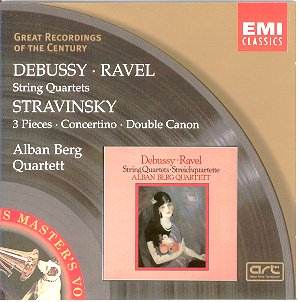Claude DEBUSSY
String Quartet in G minor
Maurice RAVEL
String Quartet in F
Igor STRAVINSKY
3 Pieces for String Quartet · Concertino · Double
Canon
 Alban Berg Quartett
Alban Berg Quartett
 EMI Classics -
Great Recordings of the Century CDM 5 67550 2 [66.22]
EMI Classics -
Great Recordings of the Century CDM 5 67550 2 [66.22]
Crotchet
Amazon
UK Amazon US

In his interesting booklet note for this EMI reissue, Tully Potter points
out that the Debussy and Ravel quartets, although thoroughly French in character,
are capable of transcending national barriers, and cites both the Quartetto
Italiano (Philips) and the Melos Quartett of Stuttgart (DG) as
providing the finest LP performances of the pre-digital stereo era. I doubt
if any EMI fan or EMI executive for that matter, would take great exception
to such praise for the competition. Even EMI's own French company
Pathé-Marconi, which had a wonderful track record of recording French
music in the post-war years, had never really cracked the 'problem' of these
two quartets and it took the arrival of the Austrian Alban Berg Quartett
on EMI's German Electrola label (rapidly promoted to EMI Classics International
for whom these recordings were made) to bring ground-breaking performances
to the HMV label.
That this recording deserves its place as a Great Recording Of The
Century (will EMI resist the apparent need to change this to 'Twentieth Century',
I wonder?) should not be in any great doubt. Again performed by non-French
players, the sheer quality of the playing and recording ensured classic status
at the time and, hopefully, a permanent entry in the international catalogues.
Recorded in 1984 for release in 1986, the Debussy and Ravel coupling enjoys
very good early digital sound. Although many sound engineers were still on
a steep learning curve with digital recordings at this time, EMI was particularly
successful in avoiding the pitfalls of over-brightness and digital sheen
that plagued products from certain other companies. Like the excellent Decca
recordings of this period, EMI used its own custom made digital recorders,
although (unlike Decca) it soon abandoned these when it found that suitably
modified machines from Sony could do the job equally well.
When the 'Great Recordings Of The Century' line was first launched, the label
was naturally perceived as 'Historical'. It comes as something of a shock
to find a CD from 1986 being included in the historical category. But for
the younger generation who need all the encouragement they can get to become
'record enthusiasts', fifteen years ago is an awful long time! It will be
increasingly interesting to see what EMI chooses for future releases in this
series - what in particular will be chosen as a release from 1999? Not that
this is the first all-digital recording to appear on 'Great Recordings'.
Clearly EMI consider the Alban Berg Quartett particularly highly as their
digital 1983 Schubert String Quintet (with Heinrich Schiff) is already available
on the label.
A word about the performances. The Debussy is never over inflected or distorted.
With admirable restraint the quartet allows the music to flow entirely naturally.
Not once does one feel a lack of Gallic style. The final movement, in particular,
shows real understanding of Debussy's intentions with a beautifully controlled
opening crescendo into the principal subject matter. The Ravel is equally
well done. This is true Ravel style, not just a general 'Frenchiness'. In
the first movement the overwhelming climax at 4.00 is brilliantly prepared.
The famous Assez vif second movement is dynamic and exciting. The
calm central section is played in such a way that the return of the fast
first tempo is made all the more effective. The slow movement never outstays
its welcome - even at 9.20 - due to the quartets rigorous maintenance of
tempi and exact note values. The cellist, Valentin Erben, makes a great deal
of the extraordinary passages (3.57 - 4.05 & 4.22 - 4.30) where Ravel
asks for a sudden outburst from the instrument, to be then gently commented
on by the three other players.
If record companies got one thing slightly wrong during this period of early
digital recording, it was programme length. The 52 minutes taken up by the
Debussy and Ravel was fine for LPs, but no-one could have guessed that more
than an hour on CD would soon become almost mandatory. The Stravinsky pieces
recorded for Electrola in 1983 make a fine new coupling and are equally well
recorded and played.
Of course 'Great Recordings' has made great play up till now of the quality
of the latest remasterings and the improvement over previous LP and CD
incarnations. I got the original Debussy/Ravel CD off my shelf (1986, complete
with the sadly missed Angel logo) and made careful A/B comparisons. Manufactured
in Japan (EMI had huge problems with CD capacity in Europe at this time)
the sound seems identical. This must be seen as praise for the original transfer
engineers and the quality techniques employed by EMI throughout the world
at this time, rather than any implied criticism of Allen Ramsey's new digital
remastering employing 'Prism SNS' noise-shaping.
At mid-price this is a marvellous purchase.
Simon Foster

